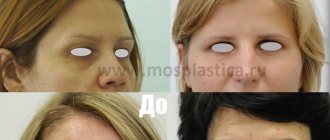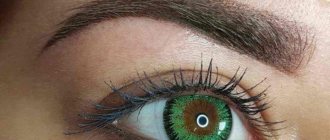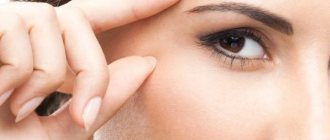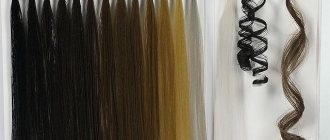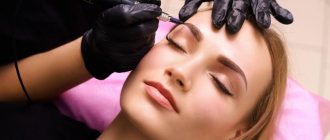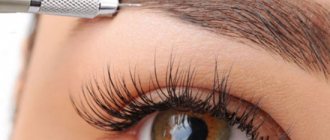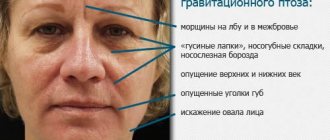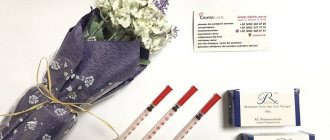Eyebrows are a natural decoration of the face, a finishing touch to character description. The arch of the eyebrows can suggest a person's psychotype. Or this is a spoiled beauty with capriciously curved arches, or maybe a sultry handsome man - a macho man with thick eyebrows that grow on the bridge of his nose.
Eyebrow transplant
Many people of both sexes are dissatisfied with the shape, thickness, and color of their eyebrows. But in some cases, changing them is simply necessary - for cosmetic reasons.
Cosmetology and aesthetic surgery are constantly evolving. New methods and methods have been developed - with their help you can make changes to your appearance, adjust the shape of your eyebrows and achieve the desired look.
Indications
- For those who have scars and hairless scars in the eyebrow area.
- For those who have completely or partially lost their eyebrows as a result of various diseases, chemical and other influences.
- For those who plucked their eyebrows for too long and vigorously and thereby spoiled them and disrupted their growth.
- For those who have serious problems with the shape, width, thickness or symmetry of the eyebrows, which are difficult to correct in other ways.
- For those who want to change their eyebrows for aesthetic reasons.
The essence of the technique
The purpose of this procedure is aesthetic correction to create harmonious facial proportions. With the help of surgical intervention, you can correct the asymmetric location of the eyebrows, their shape, as well as eliminate congenital or acquired defects.
Loss of natural beauty of eyebrows can occur as a result of:
- pregnancy (hormonal changes);
- using cheap cosmetics;
- poor nutrition;
- imbalance;
- aggressive pulling out (follicle is damaged).
Contraindications
- Poor blood clotting.
- Allergy to painkillers such as lidocaine. And without local anesthesia, the procedure is quite problematic.
- Mental disorders associated with a person’s desire to pull out hair on his body (trichotillomania).
- Diabetes.
- Pregnancy and breastfeeding period.
- Too pronounced rough scars in the eyebrow area, since in this case the probability of hair engraftment is very low.
- Autoimmune connective tissue diseases such as dermatomyositis, scleroderma and others.
An eyebrow transplant procedure should not be done if the cause that led to previous hair loss has not been eliminated.
The essence of technology
The shape of the brow ridges, their thickness, and shade have an important influence on the impression a person’s appearance makes on other people.
Fashion is constantly changing; if previously thin “threads” were at the peak of popularity, which many could afford, today everyone strives to have thick eyebrows. Arches drawn in pencil, clearly tattooed, only cause laughter and bewilderment, because they have little in common with naturalness, naturalness, which now occupy a leading position.
Unfortunately, not all women can boast of such arches. This is influenced by a number of different factors:
- genetic predisposition;
- taking medications;
- improperly performed shape correction, during which unwanted hairs are removed and the structure of the follicles is damaged;
- diffuse hair loss;
- constant influence of stress;
- leading an unhealthy lifestyle;
- poor nutrition;
- vitamin deficiency;
- some diseases;
- use of low-quality decorative cosmetics and coloring materials;
- neurological problems.
Modern cosmetology offers clients many ways to correct the appearance of the brow ridges.
Popular ways to change eyebrows:
- Daily application of decorative cosmetics in order to mask existing imperfections, obtain a brighter shade, and an ideal contour.
- Correction is carried out in a salon, where the master removes excess hair, outlines the shape, and dyes the hairs with a special composition.
- Creating a tattoo where paint is injected under the epidermis layer, allowing you to change the shade and shape of the arc.
- The use of microblading, where pigment is injected under the skin using microscopic incisions with thin blades. This leads to microscars covering the skin, which does not always look aesthetically pleasing. In addition, it is extremely important to find an experienced, professional specialist, otherwise the result will leave much to be desired.
Eyebrow hair transplantation is an alternative technique for creating thick, natural brow ridges that involves transferring hair from the donor area to the face. After passing the mandatory stage of engraftment, the transplanted waxes grow as if they had been in this area all along. This procedure makes it possible to obtain eyebrows on a face where they were completely absent, to change the density, shape, width, and length of the arches.
The transplant procedure first appeared in Japan in the 40s of the 20th century. It was used in women whose brow ridges do not grow due to wounds and burns. However, the method has not received widespread widespread use.
By the middle of the 20th century, the technique was revived by American scientists who were able to take into account all the experience of Japanese specialists. They developed a special concept according to which individual grafts were transplanted, cut into strips from donor skin.
Americans have invented new methods of treating alopecia, both in the area of the eyebrows, mustaches, and beards. In the USSR, such techniques began to be used in 1986.
Advantages
- Allows you to restore completely lost eyebrows, regardless of the reasons that led to this.
- Allows you to adjust the shape of your eyebrows and make them more attractive.
- If the shape of the transplanted eyebrows was chosen correctly, you will not need to spend a lot of time correcting them in the future.
- Does not require regular repetitions.
Alternatives
Specialists in the field of cosmetology offer their clients alternative procedures that can give the desired shape to the eyebrows, their list includes:
- False eyebrows . This method is not very convenient and unreliable; it requires daily gluing.
- Extension . This procedure is not recommended for regular use and the effect is short-lived.
- Means for stimulating eyebrow growth . The drugs are ineffective and do not restore hair after chemotherapy or in the scar area.
- Stamping, tattooing, microblading and semi-permanent restoration . This series of procedures does not restore hair, but only creates an imitation of the desired eyebrow shape.
Flaws
- The procedure is painful, although it is performed under local anesthesia. After surgery, pain will continue for at least several days.
- There are quite a lot of contraindications.
- High price.
- Since transplantation is a plastic surgery, it is quite difficult to perform such a procedure.
- Complications may arise.
- You need to wait long enough until the eyebrows take on a pleasant appearance, recover and begin to grow on their own.
- Eyebrows require careful care for a long time.
What it is?
Eyebrow plastic surgery (brow lifting, brow lifting, brow lifting) is a procedure aimed at lifting the eyebrows and the area under them. As a rule, people over the age of 30 resort to surgery, since its main goal is to correct age-related changes.
Brow lift provides these results:
- raising the eyebrows and upper eyelids;
- raising the upper parts of the cheeks;
- opening the outer corners of the eyes;
- forehead rejuvenation;
- elimination of wrinkles in the area between the eyebrows and on the forehead;
- improvement of skin tone on the temples;
- eliminating crow's feet.
What methods are there?
Patchwork (strip method)
This method is currently considered obsolete and is rarely used. It consists of a surgical procedure to remove a defective area of skin from the eyebrow area and transfer there another area of skin taken from the donor area. This new area of skin is fixed using cosmetic sutures.
However, this method is quite complex and not very effective. The transplanted area of skin takes a long time to take root or may not take root at all, hair begins to grow only a few months after engraftment, and the area of the transplanted skin itself loses sensitivity due to damaged nerve endings. In addition, scars remain both in the eyebrow area and in the donor area from where the skin fragment was taken.
Recently, this method has been improved - the skin area is not engrafted entirely, it is divided into small fragments (grafts), and then each of them is individually installed in the right place. However, many disadvantages of the method still remain.
However, this is the only way to restore eyebrow hair in cases where there is a large number of scars in the working area.
The video describes in detail hair transplantation using the strip method.
Seamless transplantation technique (STI)
This technique is less traumatic. Hair grafts are removed from the donor area non-surgically. In this case, one or two hair follicles are usually taken. They are then transferred to and inserted into the incisions made in the eyebrow area. Since the incisions are small, there are no stitches, so the aesthetics of the subsequent result are much higher. In addition, eyebrows quickly take root and begin to grow, without pain, swelling or loss of sensitivity.
This procedure is very painstaking, which is why this transplantation method is much more expensive than a patchwork one. But the result is much better.
HFE technique
This technique is currently the most common. Its popularity is determined by the fact that it is performed without surgery, therefore, there are far fewer side effects and subsequent scars. The transplantation is carried out using very thin micro-instruments, which make it possible to very carefully remove hair follicles from the donor area, without damaging either the skin or nerve endings, and then just as carefully place them in the eyebrow area, without making incisions. As a result, eyebrows heal within a few days and begin to grow quickly.
The video shows the most popular and in demand eyebrow transplant method now - HFE, showing the entire transplantation procedure and the tools used.
Possible complications
Serious complications are rare. They may be caused by the following reasons:
- An infection introduced during surgery or due to careless eyebrow care causes prolonged irritation and redness of the eyebrow skin.
- Numbness of the skin and difficulty in facial movements may be a consequence of damage to nerve endings.
- Headaches caused by an operational error or individual intolerance to anesthetic injections.
Complications are rare, but if they occur, you should consult a doctor immediately
Important ! In case of any ailments or disorders, you must immediately contact the clinic where the operation was performed.
What tools and materials are needed to carry out the procedure?
The tools primarily depend on the method to be used. If we consider the currently most common HFE technique, the set of tools and materials will be as follows:
- surgical marker for drawing the contours of future eyebrows and marking the working area for transplantation;
- a set of microtools consisting of a punch and a needle-implanter;
- microscope for selecting healthy hair follicles and counting grafts;
- lidocaine or other local anesthetic;
- cleansers and disinfectants;
- a special composition for treating follicles for their better engraftment.
Types of plastic surgery
The appropriate type of eyebrow lift is determined by the plastic surgeon, taking into account a number of factors. These include the patient’s age, the desired result, and the characteristics of the body. There are many types of procedures. The cost of the operation depends on its specific type and individual characteristics.
Transpalpebral elevation method
The operation is performed under general anesthesia. Its essence is as follows: a specialist cuts a section of skin on the upper eyelid and removes excess fat deposits and skin.
The technique is highly effective and has minimal risk of complications , which makes it quite popular. This method helps eliminate eyebrow asymmetry, sagging eyelids, wrinkles and folds in the eye area and forehead, and drooping eyebrows.
The cost of the operation in Moscow and St. Petersburg is from 25 thousand rubles.
Coronary lift (open front lift)
Coronal lift has long been considered the best brow lift procedure. It helps eliminate age-related changes, rejuvenates the face and makes it expressive. However, this technique is quite complex. It is indicated for use in cases of significant wrinkles and severe sagging skin. In other cases, more gentle methods are chosen. Also, such lifting can injure the skin, since the surgeon touches almost all soft tissues and periosteum.
The cut can be made as follows:
- Standard . It is done above the hairline. Can be used to even out the proportions of the scalp. Not suitable for patients with a high forehead, as it will make the forehead appear even larger.
- Modified . It is done from one temple to another along the hairline. This option, on the contrary, can be used for people with large foreheads.
- Along the marginal hairline . Does not change the height of the forehead, but is often recommended if there are bald patches at the temples.
After making the incision, the surgeon removes excess skin and applies sutures. The main advantage of the method is invisible scars. But there are a number of disadvantages and side effects. Thus, the areas where the incisions were made may become numb for a long time. A change in the proportions of facial features and significant injury to soft tissues is possible. There is also a long rehabilitation period. Taking all this into account, many patients choose other types.
The cost of the procedure in Moscow and St. Petersburg starts from 30 thousand rubles.
Endoscopic lift
This type of operation is much more gentle than the previous one . It has practically no contraindications except for very deep facial wrinkles and a high forehead. Men who are experiencing baldness often resort to this technique. It is done under general anesthesia. The duration of the procedure is usually 1-4 hours.
- Up to 5 incisions are made along the hairline in the forehead and temples.
- The doctor inserts special instruments into them to support the eyebrows and cut the muscles that cause wrinkles.
- Then the skin is fixed in the required position.
Most often there are no complications. method is also . It gives very quick results, and the recovery period is relatively short.
The price of the operation in large cities starts from 40 thousand rubles.
Using endotins
This method has almost no contraindications. The operation takes only 30 minutes. The surgeon makes microscopic incisions through which special plates with spikes are inserted into the skin.
Within six months after the intervention, the plates dissolve and leave behind collagen fibers, which provide a long-lasting lifting effect.
The technique has a number of advantages that make it popular:
- Reliable fastening of plates.
- Minimal likelihood of complications.
- The drug is completely eliminated from the body within six months.
- There is almost no risk of allergic reactions.
- The operation is non-invasive.
- The recovery period is very short.
The cost starts from 35 thousand rubles.
Temporoplasty
The operation takes no more than 45 minutes. The surgeon makes incisions in the temple area, removing excess fat and skin.
The method helps to lift the outer corners of the eyes and achieve clearly defined cheekbones. It can also be combined with other surgical techniques. Temporal lifting is characterized by low trauma , so it is widely popular among patients.
The price of the operation is from 25 thousand rubles.
Contour with slit
The lift is done under local anesthesia. Usually older people with pronounced wrinkles on the forehead resort to it. The operation usually leaves noticeable scars, so now it has lost its relevance.
The cost starts from 16,500 rubles.
Thread
This procedure takes only 20 minutes and can be performed under either local or general anesthesia. Its essence is the introduction of special threads under the skin of the eyebrows. They may dissolve after some time or remain under the skin. Threads provide strong fixation of the skin and a long-term lifting effect . Incisions do not result in scars. The operation is non-traumatic, and rehabilitation requires only 10 days.
Thanks to thread lifting, you can rejuvenate the skin, eliminate bags under the eyes, and slow down the aging process.
Contraindications include blood pathologies, infectious and oncological diseases, allergic reactions, and pregnancy.
Among the side effects, some patients note swelling and discomfort of the face after surgery . In addition, the qualifications of the doctor are important, since there is a risk of severe skin damage.
Cost - from 8-10 thousand rubles.
We invite you to watch a video about eyebrow thread lifting:
Contour with Botox
Quite a popular and simple procedure. Botox helps relax certain muscles , due to which others, on the contrary, are toned and provide a lift to the upper part of the face.
This method can be used for eyebrow asymmetry. With its help, you can normalize the condition of specific problem areas.
The dosage of the drug is determined by the doctor individually and depends on the severity of age-related changes.
The price of the procedure starts from 5,000 rubles per injection.
We invite you to watch a video about eyebrow lifting using botulinum toxin:
Incision along the marginal hairline
The main advantage of this type is that the place where the incision was made is practically impossible to distinguish. The surgeon removes all excess, then stitches. The technique is indicated for large bald patches . It beautifully tightens the skin and eyebrows without affecting the height of the forehead.
The starting price of the procedure is 25,000 rubles.
Biorevitalization
This is a non-surgical method that involves the use of fillers with hyaluronic acid and helps remove glabellar or horizontal wrinkles on the forehead. Acts specifically on the problem area. It is important to choose the right drug and its dosage , so the procedure should be carried out only by a good specialist.
The cost of the procedure starts from 6-7 thousand rubles.
How is it performed and how long does the procedure take?
- There is a discussion of the desired shape of the eyebrows and their design. It is determined how many follicles are needed and from which area they will be taken.
- The contours of the eyebrows are drawn with a surgical marker, and the donor area is also outlined.
- Working areas are disinfected, local anesthesia is given in the eyebrow area and in the donor area.
- Using micro-instruments, the required number of follicles is taken from the donor area.
- The taken follicles are examined under a microscope, and the required number of the healthiest ones is selected.
- Suitable hairs are treated with a special composition, which will facilitate their engraftment in the future.
- Small punctures are made in the eyebrow area, into which follicles are placed using special micro-instruments. At the same time, they are placed so that the natural direction of hair growth and angle of inclination are maintained.
The duration of the procedure depends on the number of hairs transferred. The more there are, the longer the procedure. For complete restoration of eyebrows it may take up to 5-6 hours, for partial restoration - 2-3 hours.
Help about the concepts and terms used in the article
- Alopecia (baldness, baldness) is a congenital or acquired damage caused by various circumstances; partial or complete absence of hair.
- A follicle is the same as a hair follicle, it is the root of the hair with the place from which it grows.
- Grafts are pieces of skin with a small group of follicles located in a very small, up to 1 mm, piece of skin. They are obtained by dividing a piece of leather.
- Choi implanter is an instrument with a thin needle at the very tip and hollow inside, used to create micro-incisions for introducing follicles into them.
- Punch is a manual punch used to cut grafts from donor skin.
How to care for eyebrows after the procedure?
- Immediately after the procedure, eyebrows should not be wet, but they must be washed using special products several times a day for a week.
- Once a day you need to apply a healing ointment to your eyebrows.
- The crusts that form cannot be peeled off. In addition, you should not scratch your eyebrows.
- During the week, you should avoid intense physical activity, work at an angle, and be exposed to heat.
- In the future, eyebrows must be combed regularly, styled with gel if necessary, and trimmed with nail scissors.
Expected Result
After the operation and recovery period, the patient will be able to see how the natural arch of the eyebrow emphasizes the contour of the face, and the gaze becomes more expressive.
Experts recommend going through the procedure several times, but after engraftment it will be necessary to carry out a correction (but not earlier than 6 months after the manipulation).
With the help of correction, hairs that have not taken root are added (in this case, from 50 to 100 follicles are used).
Healing period
The duration of the rehabilitation period depends on the type of threads used and the individual characteristics of the patient’s body. On average, recovery takes 1 – 3 weeks. During this time, post-procedure symptoms completely disappear and the patient can evaluate the first results of the lifting.
During the rehabilitation period, it is important to strictly follow the recommendations of the cosmetologist:
- In the first 2 - 3 days, do not touch your face with your hands, refuse decorative cosmetics.
- Treat the skin with an antiseptic solution 3 times a day until the micro-wounds are completely healed.
- Limit active facial expressions for 5–7 days.
- You are allowed to sleep only on your back, with a high pillow under your head.
- During the entire rehabilitation period, do not visit the swimming pool, solarium, sauna, or bathhouse.
- Avoid eating salty and spicy foods that contribute to the formation of swelling.
Execution technique
Eyebrows have the following distinctive features:
- hairs in the eyebrow area grow at a very large angle to the skin;
- both boundaries of hair growth (upper and lower) are clearly visible at close range;
- hairs above and below converge along the midline.
FUE technology is ideal for restoration and correction.
Video: Eyelash and eyebrow transplant
Photo: eyebrows after transplantation
In order to get the most natural result of the transplantation, you need to choose the most suitable hair thickness. While hair from the body and the back of the head can be used to restore hair on the head, such hair will be too thick and coarse for the eyebrows.
Eyebrows that are created using fine hair from the areas behind the ears or from the back of the neck will look more natural.
To make them as uniform as possible in terms of hair growth density, grafts containing 1, maximum 2 hair follicles are used for transplantation. The criterion for an excellent surgeon’s work is the aesthetic appearance immediately after the procedure: the hair follicles should be evenly spaced and form clear lines of new eyebrows.
If the skin has been significantly damaged and replaced with connective tissue (scar), then so-called “patches” are used instead of grafts. Each is a piece of skin from the temple area, which has its own artery and vein. The patch's own vessels nourish it while the tissue takes root in its new location.
Recovery time and effect after transplantation
Recovery after an eyebrow transplant takes an average of 14 days. During this time, you may experience swelling, redness and bruising - this can also go down under your eyes. The doctor reassures: there is nothing wrong with this, and within two weeks these consequences will completely disappear.
As for the result, the procedure will help make eyebrows thicker and correct their natural shape, but it takes time to evaluate the effect of eyebrow transplantation. “Hair has only three phases in its life cycle, and active growth is observed only in the first. If your hairs were in the growth phase at the time of transplantation, the likelihood that they will take root and continue to grow is very high. If this phase is behind you, and at the time of transplantation your hair was in the second or third phase of its life cycle, then it will fall out in the next few weeks after planting. However, there is no need to be afraid of this. Remember that only the hair falls out, but the follicle remains. Two to three months after the old hairs fall out, the next generation of strong hair will appear,” says plastic surgeon Artur Alexandrov.
View on Instagram
